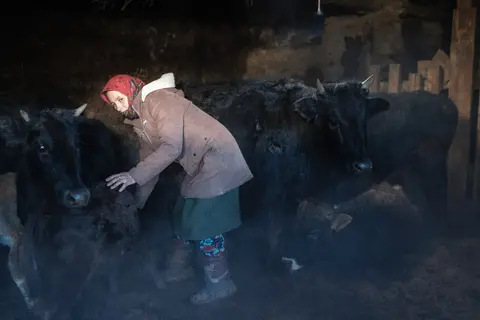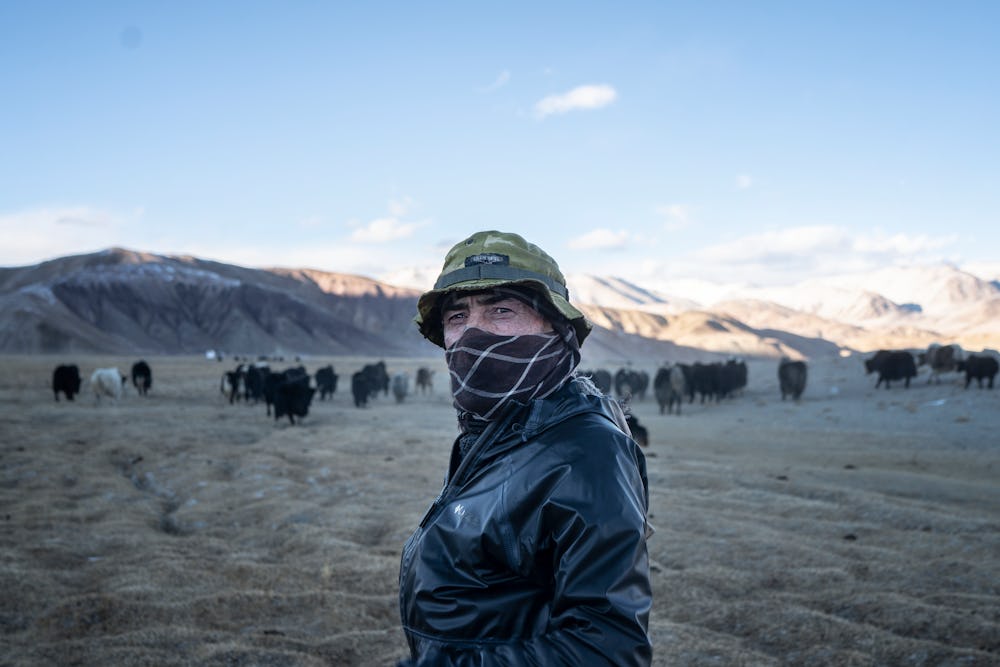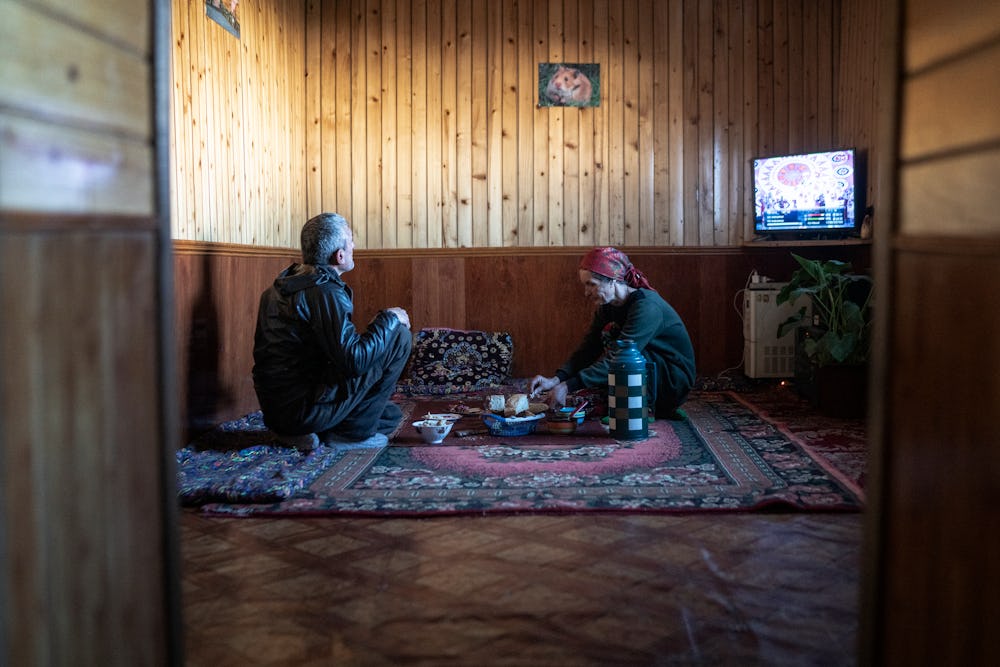Part one in a three-part series
BAKHTON DONIYOR, 50, LIGHTS A FIRE WITH COAL CHUNKS AND DRIED MANURE IN THE WOOD STOVE OF HER HOUSE IN BULUNKUL, A VILLAGE IN THE AUTONOMOUS REGION OF GORNO-BADAKHSHAN IN EASTERN TAJIKISTAN.
Her husband, Bulbulov Doniyor, 55, spoons instant coffee into a glass mug and kneels at the end of a colorful floor cloth, covered with plates of sweets, biscuits, goat cheese, and traditional Tajik naan.
“You know,” Bulbulov says while breaking the bread, “I think she’d been relieved had the wolves got the better of me last winter.”
High up in Tajikistan’s Pamir Mountains, the wolves prey on the livestock tended to by semi-nomadic herders like Doniyor. But melting glaciers and increasingly extreme weather patterns are rewriting the rules of play for all the residents here on “the roof of the world.”

As a nonprofit journalism organization, we depend on your support to fund more than 170 reporting projects every year on critical global and local issues. Donate any amount today to become a Pulitzer Center Champion and receive exclusive benefits!

And so, last winter, wolves descended from the mountains and went straight for the shepherd, instead of the sheep.
“I was certain that I would die,” Doniyor says, pointing towards the surrounding ranges. Barren and desolate. No place to hide.
Aided by Yuri, his herding dog, Doniyor fended off the wolf pack with his wooden stick. He does not hold a license for a rifle.
Bakhton laughs and nods theatrically, feigning pleasure at the thought of being widowed, but then she sighs and joins her husband on the floor.
“I’m worried every time he’s out there,” she says, “especially alone with the animal. You have only yourself to rely on — and nature’s cruel.”
“Wolves can strike at any time of the day,” Bulbulov says. “In the end, we got away,”
He and his dog managed to chase the wolves off, but the pack took the shredded remains of one of Bulbulov’s sheep away with them. “Yuri took some nasty hits but stood firm on my side.”
“I WAS CERTAIN THAT I WOULD DIE.”
To people in Bulunkul — a village of about 20 houses 13,000 feet above sea level and primarily inhabited by livestock breeders who spend the warmer months in portable yurts — wolf attacks are nothing new. Wolves habitually enter the village in packs, preying on livestock kept either in barn-like structures or behind walls of clay.
Winters here are similarly unforgiving — but in early 2021, temperatures slumped to an unprecedented minus 76 degrees Fahrenheit. The cold forced many herders to keep their animals inside their homes to prevent them from freezing to death — but that didn’t necessarily save them from starving to death. The wolves, which grew ravenous and desperate, came even more often to Bulunkul in search of either livestock or the shepherds tending them.
“We’d seen it coming for a few years, but last winter was the game-changer,” Bulbulov says. “Nothing’s been the same ever since.”
“This year might turn out even worse,” adds Bakhton.
In the spring, signs of the famine that had driven the wolves to such desperation became visible along the slopes of the Pamir Mountains. All kinds of wildlife had starved as the thick ground frost made it impossible to dig for roots, grass, or hibernating rodents.

The Pamirs account for 45 percent of Tajikistan’s land — and host at least 16 peaks taller than 20,000 feet — but are home to just three percent of Tajikistan's total population of 9.5 million.
Tajikistan became independent from Russia in 1991 but instantly descended into a civil war. Islamist guerillas set up strongholds in the Pamirs with hopes of eventually defeating the post-Communist regime led by former Communists in the capital, Dushanbe.
By 1997, the war had cost nearly 100,000 lives and the Islamists lost, but the region of Gorno-Badakhshan was granted large-scale autonomy.
Now, many claim that autonomy merely increased the social and economic inequities between isolated communities such as Bulunkul and the power corridors in Dushanbe.
“WE’D SEEN IT COMING FOR A FEW YEARS, BUT LAST WINTER WAS THE GAME-CHANGER.”
The coal industry never came this far east during the Soviet era; neither did any other kind of industry worth mentioning. Agriculture is hard in the unforgiving mountain terrain, as few plants or trees survive on these slopes. Livestock breeding was and has remained people’s best ticket to economic survival.
“I can’t recall a life without yaks,” says Bulbulov. As a young man, he tried: He was a truck driver transporting goods to Dushanbe, as well as to neighboring Kyrgyzstan and Afghanistan. In 1979, when the Soviet Union invaded Afghanistan, Bulbulov delivered goods and commodities to Soviet troops.
When the Soviet empire collapsed, many Tajiks found themselves in desperate need of an income. Bulbulov turned to herding.

But now, people like Bulbulov in the Pamirs face an uncertain future, as increasingly unpredictable climate patterns have both turned winters cruelly cold and summers punishingly dry. The soil is becoming saltier, and the animals are less able to survive the winters — despite the price-inflated food brought in from Dushanbe.
“Our animals are used to the salty grass around here — they won’t touch the Dushanbe forage,” says Bulbulov. “They rather starve and lose weight. At spring, many are nothing but skin and bones, with little meat to offer.”
“TODAY IS MY LUCKY DAY.”
In 2020, Covid-19 struck and the herders’ usual trading routes — the roads to Kashgar in Chinese Xinjiang, and to the historical city of Osh in Kyrgyzstan — closed. Prices of wheat, cooking oil, gasoline, and, worst of all, animal feed spiked.
Meanwhile, says Bulbulov, “the price for meat isn’t what it used to be, or should be, nowadays.”
People began slaughtering their livestock for fast cash.
“We need money to pay for our children’s education and health care, and to provide for ourselves,” he says.

The next morning, Bulbulov prepares a thermos and a backpack with bread, meat, and sweets. The shepherds of Bulunkul, it seemed, were taking turns herding their livestock out to graze.
“It’s my turn,” he says, making a face. “Today is my lucky day.”
Bakhton, who works as a school supervisor in the 2,000-person town of Alichur, some 30 minutes away, has to leave for a meeting, but she milks the cows and helps Bulbulov with the yaks before she departs.
As Bulbulov heads for grazing land, other shepherds greet him, walking alongside and talking for a bit; one by one, they depart, leaving Bulbulov and his dog Yuri alone with the animals.
“THE SEASONS USED TO FOLLOW SET CYCLES. NOW, WINTERS ARRIVE EARLIER EVERY YEAR.”
The yaks, sheep, and cows follow in the footsteps of Bulbulov’s rubber shoes. He picks up his phone and holds it high up in the air. “No signal, it never is in Bulunkul,” Bulbulov laments before putting the phone away.
He takes the animals and heads for the slopes on the other side of Lake Bulunkul, a saltwater lake that is an important pit stop for migrating birds.
“Everything changes,” says Bulbulov Doniyor. “The seasons used to follow set cycles. Now, winters arrive earlier every year. Then, it’s just to wait, wait, and wait. Up here, we live like marmots; we go into hibernate mode. And just like the animals, we break through on the other side, come spring, bare to the bones.”




